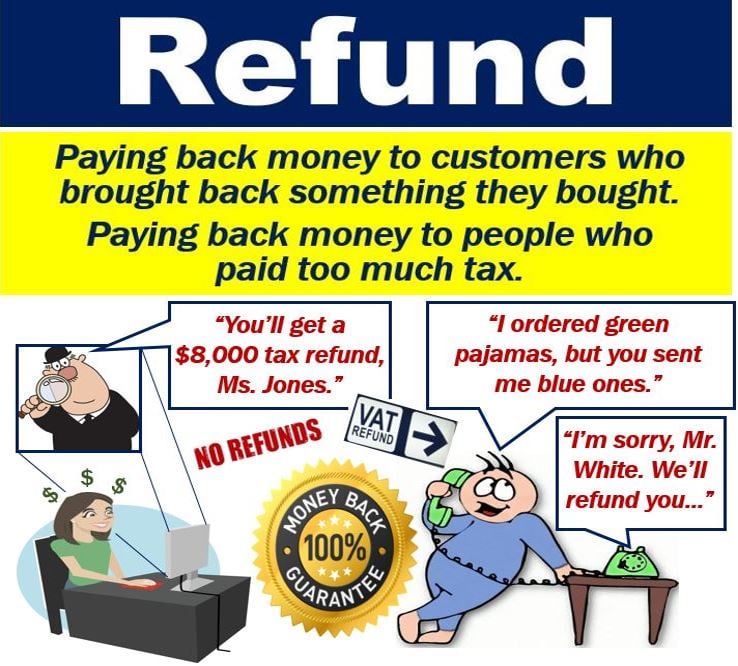What is a refund? Definition and examples
A refund usually means getting your money back when you return something you had bought. You return the product because you don’t want it. Sometimes, rather than giving money, the seller may either give you a replacement item or a voucher. In most cases, the voucher is only usable at that store.
A voucher is a piece of paper that entitles the holder to a free product, service, or a discount.
The amount the seller returns to you is usually equal to how much you spent.
Technically, the term refers to either returning the customer’s money, offering a replacement item, or giving a voucher. If referring only to returning the money we use the term ‘cash refund.’
Some people, however, say that the term ‘refund’ on its own only refers to giving customers their money back.
Reasons for refunds
If a customer buys a product that is faulty, they will probably return it to the store where they bought it. The retailer will subsequently give them a refund.
Many stores will also give customers their money back if they are simply not satisfied with their product. This policy is more common in the advanced economies than in the emerging or developing economies.
Some retailers will even give you your money back without demanding a reason.

If you shop online, you are much more likely to ask for a refund than somebody who shops in the traditional way. Online shopping refers to buying things on the Internet while traditional shopping involves physically going to the shop.
Products and services
Getting your money back does not only apply to products, but to services too. Window cleaning, gardening, and decorating are examples of services that households pay for.
If you don’t think your window cleaners did a good job, you should tell them. They may offer you a free service next time or give you your money back.
Some restaurants will not charge you for your meal if you complain about it. Others may offer you a free dessert or give you a voucher so that your next meal is ‘on the house.’
The Investor Glossary has the following definition of the term: “A refund usually refers to the reimbursement of funds to a customer for a product or service provided, for reasons such as defects in merchandise or dissatisfaction with labor performed.”
In addition, there is also what’s known as a tax refund, which is the government’s return of excess taxes to taxpayers.
Refund – example
A customer who bought an item of clothing may ask the store for their money back if it didn’t fit.
At a restaurant, you may ask for them to return your money if you find a strand of hair in your soup.
Your rights as a consumer vary from country to country. In some jurisdictions, you are within your rights to demand your money back if an item is faulty.
Some jurisdictions give customers the right to a refund if the seller makes misleading claims. Jurisdiction, in this context, refers to a geographical area that a legal system covers.
In California, the Customer Returns and Refund Law says that customers may get a full cash refund, store credit, or exchange of product within the next seven days of purchase.
If the shop fails to do this, then customers have 30 days to ask for the refund instead.
Cash vs. tax refund
When a customer wants a refund and will only take money for it, we call it a ‘Cash Refund.’
Tax refunds occur when taxpayers have paid too much tax.
You may also get a sales tax or VAT refund if you go shopping abroad. There is a special place at airports that give you back what you spent on sales taxes or VAT. This only applies to visitors to a country. VAT stands for value added tax.
In the U.S., the Internal Revenue Service (IRS) is in charge of issuing the tax refunds. According to the IRS, about 90% of the people file for their tax refunds digitally.
In 2016, the IRS returned about $268 billion in overpaid taxes.
A marketing strategy
In some companies, refunds may be a key strategic selling point. They may also be part of a strategy to gain or strengthen customer loyalty or brand loyalty. Brand loyalty refers to consumers having a specific preference for a product or brand. Customer loyalty, where the focus is more on prices and special offers, refers to repeat business.
A company may have a promotion that says ‘100% money-back guarantee – no questions asked.’ Customers then know that their money is not at risk if they don’t like the product.
This marketing money-back guarantee strategy is often successful. However, sellers are taking a risk, i.e., they are betting on there being a small number of complaints.
A marketing strategy is a comprehensive plan that includes all of a marketing company’s goals and objectives.
Video – tax refunds
Tax refunds usually occur because taxpayers paid more than they actually owe. This TurboTax video tells American taxpayers how to claim their refund.

